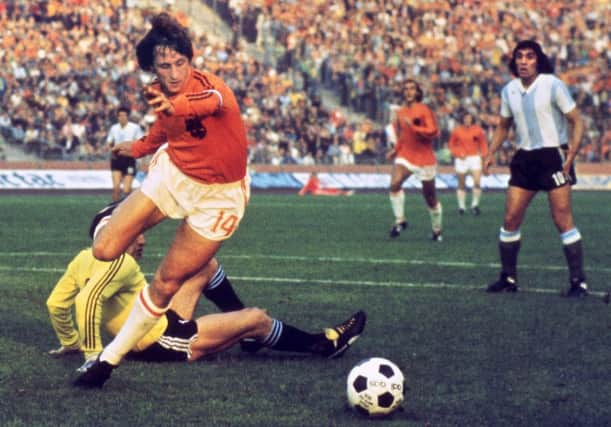Dutch master Johan Cruyff turned football into an art form


Remember 1972 and that Celtic-Inter Milan semi-final in the European Cup? Football’s image was pretty stodgy after the Italians had ground out victory on penalties following two 0-0 draws, with the unfortunate, unballetic Dixie Deans missing his kick to send dour Inter to the final. No matter, Ajax were waiting for them. Score: Cruyff 2, Catenaccio 0.
That was the middle of Ajax’s three triumphs confirming them as kings of the continent. The following year their total football – a revolutionary theory based on movement, flexibility and swift short-passing – would do for Juventus and prompt some Italian coaches to, if not quite reject, then at least modify the game-throttling tradition of rigid man-marking.
Advertisement
Hide AdAdvertisement
Hide AdIn the early 1970s Dutch footballers were conquering football with the swagger and certainty of Dutch explorers 400 years before – and Cruyff was right at the helm. Ajax were super-cool in those shirts with the broad strip down the front which were much- copied – in Scotland by Hearts – and their star man looked pretty special, too. Slight, thin-faced, the slenderest of limbs – and topped off with a terrific haircut. As Duncan Hamilton points out in his biography of George Best, these were also the features of the Belfast boy. Back then only Cruyff came close to Best, and only Best came close to Cruyff, as Hamilton explains: “Cruyff possessed more skill than anyone – with the exception of Best and Pele – could have expected God to have given them without considering Him to have been over-generous.”
After Pele scored his 1,000th goal and delivered the most devastating pass of no more than two feet that football had ever seen – for Brazil’s final goal to win the 1970 World Cup – the stage was vacated and we all thought Best could justifiably call himself the greatest. But Cruyff in 1971 would do what Best had done three years earlier: win the European Cup at Wembley, walk off with the prize for being the continent’s best.
Best watched Ajax overwhelm Panathinaikos from a bar in Majorca and there was total respect between the two swashbucklers. This was a rivalry every bit as thrilling as that between Lionel Messi and Cristiano Ronaldo, only in an age of much less hype and braggadocio we probably didn’t realise it.
Best got a bit annoyed when Cruyff’s likeness replaced his in Madame Tussauds – can you imagine a similar thing happening now without Ronaldo urging Portugal to declare war on Argentina? The Northern Irishman vowed to nutmeg Cruyff the next time they met on the pitch – and he succeeded – but the Dutchman had the advantage of playing for a superior club and a country intent on expanding total football into the international arena.
After making Italy’s fabled defensive stratagem splutter and gunk up like an ancient Gaggia, Cruyff wanted to do something similar to the precision-engineered German model, and he almost did. In the 1974 World Cup final, straight from kick-off, he powered through the heart of the West German side, making his supposed shadow, Berti Vogts, look like a Tussauds dummy. A penalty was won and duly converted, but then Holland decided to show off. They had been far and away the best side in the tournament but Dutch arrogance got the better of them.
“We Dutchmen are pig-headed,” Cruyff once said. Maybe the most pig-headed of them all, he would sign a boot deal with Puma then turn up in Adidas complaining the former hurt his feet. “We’re always telling people how to do things. In that respect we’re an unpleasant nation.”
Still, it had been a beautiful failure, by a beautiful footballer.